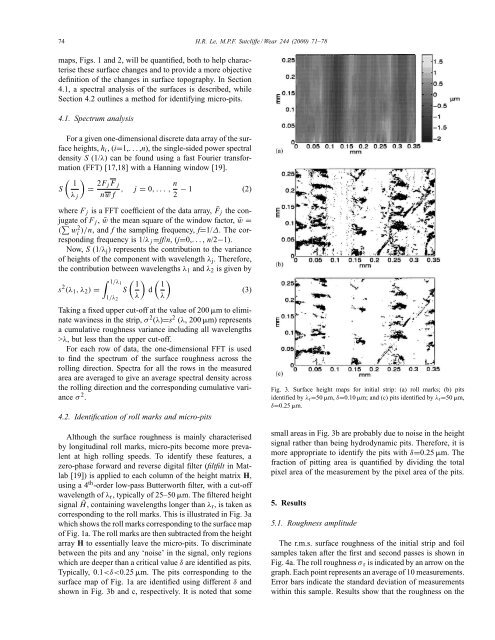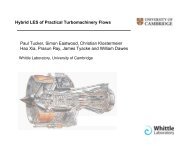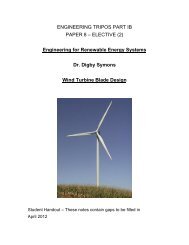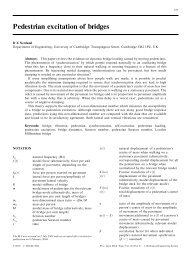Analysis of surface roughness of cold-rolled aluminium foil
Analysis of surface roughness of cold-rolled aluminium foil
Analysis of surface roughness of cold-rolled aluminium foil
You also want an ePaper? Increase the reach of your titles
YUMPU automatically turns print PDFs into web optimized ePapers that Google loves.
74 H.R. Le, M.P.F. Sutcliffe / Wear 244 (2000) 71–78<br />
maps, Figs. 1 and 2, will be quantified, both to help characterise<br />
these <strong>surface</strong> changes and to provide a more objective<br />
definition <strong>of</strong> the changes in <strong>surface</strong> topography. In Section<br />
4.1, a spectral analysis <strong>of</strong> the <strong>surface</strong>s is described, while<br />
Section 4.2 outlines a method for identifying micro-pits.<br />
4.1. Spectrum analysis<br />
For a given one-dimensional discrete data array <strong>of</strong> the <strong>surface</strong><br />
heights, hi,(i=1,...,n), the single-sided power spectral<br />
density S (1/λ) can be found using a fast Fourier transformation<br />
(FFT) [17,18] with a Hanning window [19].<br />
<br />
1<br />
S<br />
λj<br />
= 2Fj F j<br />
nwf<br />
, j = 0,... ,n − 1 (2)<br />
2<br />
where Fj is a FFT coefficient <strong>of</strong> the data array, ¯Fj the conjugate<br />
<strong>of</strong> Fj , ¯w the mean square <strong>of</strong> the window factor, ¯w =<br />
( w2 i )/n, and f the sampling frequency, f=1/∆. The corresponding<br />
frequency is 1/λj =jf/n, (j=0,..., n/2−1).<br />
Now, S (1/λj) represents the contribution to the variance<br />
<strong>of</strong> heights <strong>of</strong> the component with wavelength λj. Therefore,<br />
the contribution between wavelengths λ1 and λ2 is given by<br />
1/λ1<br />
<br />
s 2 (λ1,λ2) =<br />
1/λ2<br />
S<br />
1<br />
λ<br />
d<br />
1<br />
λ<br />
Taking a fixed upper cut-<strong>of</strong>f at the value <strong>of</strong> 200 m to eliminate<br />
waviness in the strip, σ 2 (λ)=s 2 (λ, 200 m) represents<br />
a cumulative <strong>roughness</strong> variance including all wavelengths<br />
>λ, but less than the upper cut-<strong>of</strong>f.<br />
For each row <strong>of</strong> data, the one-dimensional FFT is used<br />
to find the spectrum <strong>of</strong> the <strong>surface</strong> <strong>roughness</strong> across the<br />
rolling direction. Spectra for all the rows in the measured<br />
area are averaged to give an average spectral density across<br />
the rolling direction and the corresponding cumulative variance<br />
σ 2 .<br />
4.2. Identification <strong>of</strong> roll marks and micro-pits<br />
Although the <strong>surface</strong> <strong>roughness</strong> is mainly characterised<br />
by longitudinal roll marks, micro-pits become more prevalent<br />
at high rolling speeds. To identify these features, a<br />
zero-phase forward and reverse digital filter (filtfilt in Matlab<br />
[19]) is applied to each column <strong>of</strong> the height matrix H,<br />
using a 4th-order low-pass Butterworth filter, with a cut-<strong>of</strong>f<br />
wavelength <strong>of</strong> λr, typically <strong>of</strong> 25–50 m. The filtered height<br />
signal H ˜ , containing wavelengths longer than λr, is taken as<br />
corresponding to the roll marks. This is illustrated in Fig. 3a<br />
which shows the roll marks corresponding to the <strong>surface</strong> map<br />
<strong>of</strong> Fig. 1a. The roll marks are then subtracted from the height<br />
array H to essentially leave the micro-pits. To discriminate<br />
between the pits and any ‘noise’ in the signal, only regions<br />
which are deeper than a critical value δ are identified as pits.<br />
Typically, 0.1







